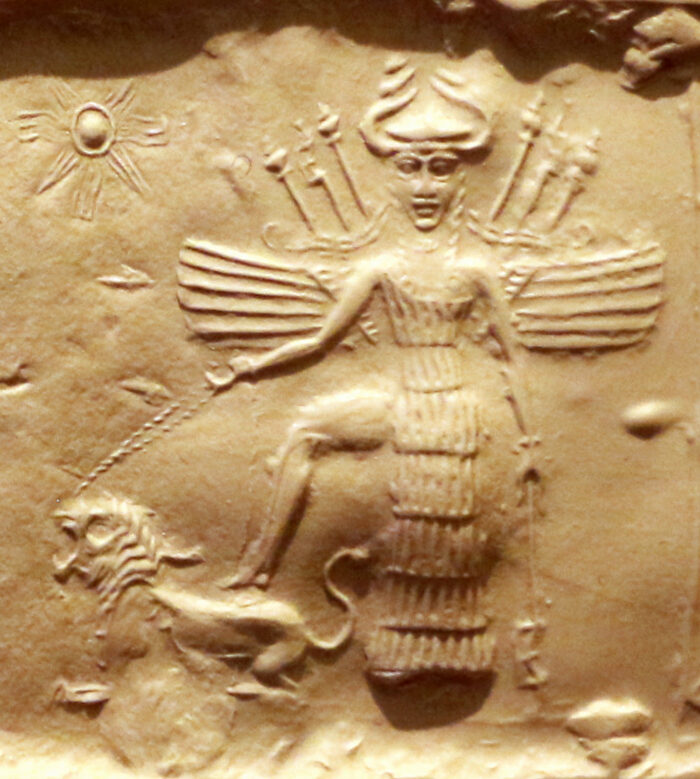Here lies a blank notecard full of possibilities. From what I remember about AP art history, it was a blur of spoon fed powerpoint facts I never questioned, but always memorized. Flashcards were all the rage before the big test, and although I got a 5 -and ultimately decided this subject was my calling- college art history courses would challenge me in a way I never thought possible: challenging the facts using my own critical thinking.

Context: All you Need to Know is Social Strata
It seems that in the fall of my high school junior year, I hastily jotted down “Uruk was a large city, population 40,000”, as if that had anything to do with life in either of these city-states. I had a picture in my head of a colony of seemingly equal worker bees creating giant structures in these Sumerian city-states. But sometimes AP art history wears rose colored glasses.
Cuneiform tells us most about what values this civilization held near and dear. But there is one major obstacle in our quest for truth: Ur’s social stratification is defined by an entire population’s acceptance of a gap separating the “ideal from the real”, which can make it hard for truth seekers like us to really glean the truth from their creations, both architecturally and artistically. There was an educated class of scribes that relayed this kind of biased information, centered around legends of the king’s unification with the patron god or goddess of the state. In this case, the patron goddess Inanna of Ur. Sumerian Kings like Nabondnius and Nebuchadnezzar wanted war as represented by the winners in the art that they commissioned. Opposed to what the wide, shallow staircase of the Ziggurat suggests as an easy access point for common worshippers, only the elite, namely priests and kings, were allowed to ascend and communicate with the goddess. When talking about the distant past, we are structurally duped to look at the 1%, not the other 99%. If you study art history, you’re definitely more elitist than you ever bargained for. Maybe check yourself next time you praise the high society of the Sumerians.
Content: Inanna is Not Who You Think She Is
“Meant to glorify gods that lived above people.” Yes, thank you 16 year old Abby for giving us the perfect fast fact for a flashcard. You probably learned in AP class that the ziggurat was built to perform worship to a god, with the most perfect little temple in the center of the structure. But this particular goddess, Inanna of Ur, has many more layers to her than being a simple moon goddess. How dare AP Art History teachers gloss over her all powerful mightiness!
On three sides, with the exception of the Northeast side, the ziggurat walls rise straight from the ground. Wide, ascending stairs lead to the summit on the NE side, creating space for ritual parades, reminding us of a modern day funerary procession (as seen with the death of a recent dignified British monarch). But in this case, ritual parades for a goddess. Her name is Inanna, and she is patron goddess of Ur. Thanks to her image on an ancient Akkadian seal, we know the ancient Mesopotamians pictured her as a fierce, sexual, and powerful goddess of many life or death aspects of their lives. Yes, she was the moon goddess, but she was also the goddess of fertility, marital sexuality, warfare, agriculture, and… prostitutes. In the words of Professor Johanna Stuckey, “She represents the non-domesticated woman, and she exemplifies all the fear and attraction that such a woman elicits.” She singlehandedly reverses the patriarchal hierarchy in Sumerian society by seeking sexual experiences and yes, exulting in battle. Inanna was a goddess who behaved like a man, and she was in no way tied to a patriarchal family. The power of a woman to bring forth life, but also take it away, was manifested enough in this one goddess to make up for an entire civilization! (hot take). From seeds to storehouse grain to military victory, their survival depended on her… and her relationship with the king.

Form: No Straight Lines???
Yes, “mud brick” might get you a 5 on the AP exam for inquiries on the form of a ziggurat. But it ultimately led to demise in my own critical thinking. Only later in college was I forced to reckon with latent primitive, stereotyped notions of the Sumerians in my head by the acceptance of such a simple fact. If you’re me, you imagined simple-minded, thoroughly religious people slumming it in mud pits creating a structure like they were building legos. But what you didn’t learn was the Sumerians had architectural feats to rival the Egyptians. Move over pyramids!
For example, if you look reeeeally close, you will notice there is not a single straight line in the structure. Each wall, from base to top and horizontally from corner to corner, is a convex curve, a curve so slight as not to be apparent but giving to the eye of the observer an illusion of strength where a straight line might have seemed to sag under the weight of the superstructure. The Sumerians who built it accomplished feats of architecture and engineering with an incredible awareness of the land they called home. For instance, because the unbaked mud brick core of the temple would, according to the season, be alternatively more or less damp, the architects included holes through the baked exterior layer of the temple allowing water to evaporate from its core. Additionally, drains were built into the ziggurat’s terraces to carry away the winter rains. Even more impressive: the first ziggurat was built centuries before the pyramids. The Sumerians honestly don’t get enough credit for their feats: it seems the Egyptians get all the attention.

Function: Catholic Confession Mixed with an All You Can Eat Buffet
Bear with me: I’m almost done exploding your flashcards. Let’s dive a little deeper into the function of such an architectural feat beyond “temple stands high on ziggurat” (I’m not even sure what I meant by that statement). This worship of the goddess took the form in a ritual known as “Sacred Marriage.” To be more specific, Inanna bestowed power on Ur’s ruler and ensured the fertility and prosperity of the land and its people. As the Ziggurat supported the temple of the patron god of the city of Ur, it is likely that it was the place where the citizens of Ur would bring agricultural surplus and where they would go to receive their regular food allotments. In short, to visit the ziggurat at Ur was to seek both spiritual and physical nourishment. Sometimes AP art history has to pass up on these fascinating facts for the sake of time, trust me I’ve been there. 250 works of art is quite a large number.
Author: Abby Shadwick
Shadwick is from Lexington, Kentucky and is part of the Colgate class of 2025. AP Art History in high school is what first inspired her to take the art history path at Colgate, and she certainly has no regrets.
